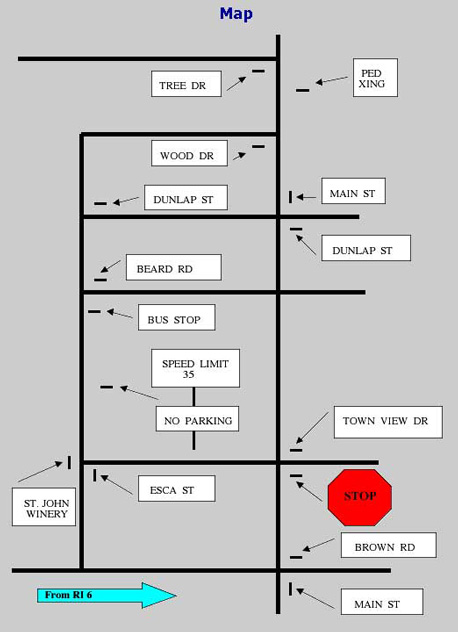The Annual April Fools Rallye
Paper Map Rallye
General Instructions Map Scoring Critique
To acquaint yourself with how an A-B Rallye operates, try this short Paper Map A-B Rallye. An A-B Rallye differs from a Time and Distance Rallye and a Course Marker Rallye, in that there is no speed involved and you are not looking for course markers. In addition, an A-B Rallye gives you two part Route Instructions, so it is very unusual for anyone to get lost. Lastly, the first one to finish an A-B Rallye generally does not have the best score.
Use the definitions, General Instructions and Route Instructions as you travel on this Paper Map A-B Rallye. This Paper Map A-B Rallye assumes that you have completed the first six route instructions and starts with the seventh route instruction. Start the route at the bottom of the paper map.
Definitions
- AT: As close as possible to.
- C: Continue past the indicated sign.
- CH: Any intersection where pavement meets but does not cross.
- L: A turn to the left of between 10-175 degrees.
- ON: The street naming sign must be on your left as you pass it.
- OPP: A chance to turn, counting only named roads.
- R: A turn to the right of between 10 and 175 degrees.
- RIP: All of the words on the sign do not appear in the instructions.
- " " : All of the words and numbers in quotes must appear on the signs.
General Instructions
- Route Instructions will have two lettered parts, labeled A and B. Act on the one you can execute first, either A or B.
- If A and B are both valid and can be executed at the same place or intersection do A and select C for your answer.
- Signs on a common support are to be considered the same sign.
- The abbreviations of the words, road, street, drive and the word, Beard, do not exist on signs.
- Do not split words, (i.e., Dogwood will never be Dog wood).
- When an instruction has no quotes the road itself is being referred to.
| Route Instructions | ||
|---|---|---|
| No | Instruction | Answer |
| 7. |
A: L ON MAIN B: L AT "MAIN" |
|
| 8. |
A: L AT "STOP" B: L AT "TOWNVIEW" |
|
| 9. |
A: R AT ESCA B: R AT RIP "JOHN WINERY" |
|
| 10. |
A: C AT "35 NO" B: C AT "BUS STOP" |
|
| 11. |
A: R AT DUNLAP B: R SECOND OPP |
|
| 12. |
A: L AT MAIN B: L FIRST OPP |
|
| 13. |
A: C AT "PED XING" B: C AT WOOD |
|

A-B Rallye Paper Map Critique
The following explains why one choice is correct and another choice is not correct, given that you're using the General Instructions, Definitions, Route Instructions and paper map above. The instructions assume that you have completed the first six route instructions and starts with the seventh route instruction.
Route Instruction |
Correct Answer | Reason |
|---|---|---|
| 7. | B | Part A is incorrect, because the definitions stated "on" was: The street naming sign must be on your left as you pass it. In this case the street naming sign on the map is on your RIGHT as you pass it, so not a valid ON instruction. |
| 8. | A | The B part of the RI was "Townview" and on the sign it was "TOWN VIEW" and the General Instructions stated: Do not split words, so not a valid "TOWNVIEW" sign. (i.e., Dogwood will never be Dog wood). |
| 9. | A | The B part is bad because you were looking for an RIP "JOHN WINERY" and RIP means all of the words on the sign do not appear in the instruction. The sign on the map was ST. JOHN WINERY, which is not RIP, because the General Instructions stated the abbreviation for the word STREET did not exist on signs, and ST is an abbreviation for street. So, therefore "JOHN WINERY" is a fully quoted sign, not an RIP sign. |
| 10. | A | In part A the "35" is on one sign and the "NO" is on another sign. And the definitions stated: all of the words and numbers in quotes must appear on the sign, while the General Instructions stated signs on a common support are to be considered the SAME SIGN, and part A comes first. |
| 11. | A | In part B you were counting OPP's and an OPP was a chance to turn, counting only named roads. The first road you came to on the map was BEARD, and the General Instructions stated the word BEARD did not exist on signs, so the road is not named, so not an OPP. |
| 12. | C | Both A and B are valid, because they can be executed at the same place or intersection, the General Instructions say do A and mark C. |
| 13. | A | Part B is bad because the definitions state C is continue past the indicated SIGN, and when an instruction has no quotes the road itself is being referred to. In part B, WOOD is not in quotes, so not a SIGN, but the road itself. |
